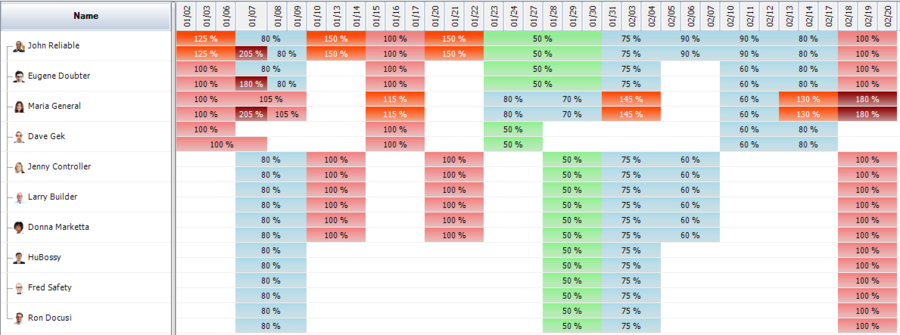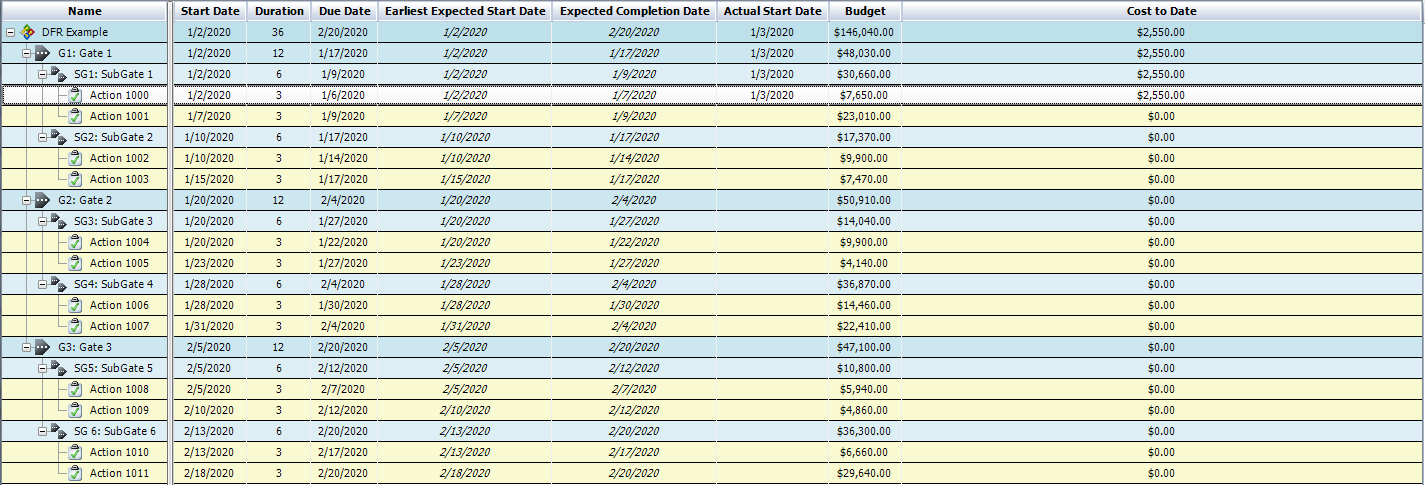Planned, Expected and Actual
| This is a subpage of a larger section. | |
| Return to: DFR Planner |
Planned, Feasible and Actual
- Planned dates and data hold the original dates and data (start end, duration, cost etc.) put in the planner.
- Actual dates and data hold the final actual dates and data as recorded by the team on task/action/gate start/completion.
- Feasible dates and data are automatically and continuously updated based on how the project progresses.
- Feasible Start Date is the earliest possible date the gate or action can start (based on prior dependencies).
- If there is no precedence or dependencies this is equal to the planned start date.
- If there is a precedence then this is the earliest start date possible, after the completion of the precedence.
- Feasible End Date is the expected completion date.
- This is the "Feasible Start Date + Planned Duration".
- Feasible Window is the length (in days) of the available time window to complete the action/gate.
- Feasible Start Date is the earliest possible date the gate or action can start (based on prior dependencies).
In the ideal scenario, where each item is completed on-time and exactly as planned, all three are the same. In the real world however this is rarely the case.
Example
Consider the project shown in the table below comprised of three top level gates, six sub-gates and 12 actions.
| DFR Example | |||
| G1: Gate 1 | |||
| SG1: SubGate 1 | |||
| Action 1000 | |||
| Action 1001 | |||
| SG2: SubGate 2 | |||
| Action 1002 | |||
| Action 1003 | |||
| G2: Gate 2 | |||
| SG3: SubGate 3 | |||
| Action 1004 | |||
| Action 1005 | |||
| SG4: SubGate 4 | |||
| Action 1006 | |||
| Action 1007 | |||
| G3: Gate 3 | |||
| SG5: SubGate 5 | |||
| Action 1008 | |||
| Action 1009 | |||
| SG6: SubGate 6 | |||
| Action 1010 | |||
| Action 1011 |
Planning Stage
Settings and Assumptions
- There is a same level precedence for each Gate and Sub-gate. No precedence is set for the actions within a gate, however the plans calls for them to run sequentially.
- Monday, Tuesday, Wednesday, Thursday and Friday are workdays. Weekends include Saturday and Sunday. Holidays include December 25th, July 4th, January 1st, the fourth Thursday of November, the first Monday of September, and the last Monday of May. This is set through the Work Days Scheduler interface, which can be found in Manage Repository under the Repository Settings.
- Each Action has a duration of three days.
- Actions start at the beginning of the workday assigned (i.e. first thing in the morning) and end at the end of the workday assigned. For example a two day action starting on January 1 would be completed on January 2 (e.g. all day on day 1 and all day on day 2).
- Action 1 starts in January 2, when completed Action 2 starts and so forth.
- No lag time between gates and actions.
Planned Dates
Based on the above settings and assumptions, including weekends and holidays, the planned dates would be as follows:
| Planned Dates | ||||||
| Start Date | Duration | End Date | ||||
| P1: Project 1 | Jan-02 | 50 | Feb-20 | |||
| G1: Gate 1 | Jan-02 | 16 | Jan-17 | |||
| SG1: SubGate 1 | Jan-02 | 8 | Jan-09 | |||
| Action 1000 | Jan-02 | 5 | Jan-06 | |||
| Action 1001 | Jan-07 | 3 | Jan-09 | |||
| SG2: SubGate 2 | Jan-10 | 6 | Jan-15 | |||
| Action 1002 | Jan-10 | 5 | Jan-14 | |||
| Action 1003 | Jan-15 | 3 | Jan-17 | |||
| G2: Gate 2 | Jan-20 | 16 | Feb-4 | |||
| SG3: SubGate 3 | Jan-20 | 8 | Jan-27 | |||
| Action 1004 | Jan-20 | 3 | Jan-22 | |||
| Action 1005 | Jan-23 | 5 | Jan-27 | |||
| SG4: SubGate 4 | Jan-28 | 8 | Feb-04 | |||
| Action 1006 | Jan-28 | 3 | Jan-30 | |||
| Action 1007 | Jan-31 | 5 | Feb-04 | |||
| G3: Gate 3 | Feb-05 | 16 | Feb-20 | |||
| SG5: SubGate 5 | Feb-05 | 8 | Feb-12 | |||
| Action 1008 | Feb-05 | 3 | Feb-07 | |||
| Action 1009 | Feb-10 | 3 | Feb-12 | |||
| SG6: SubGate 6 | Feb-13 | 8 | Feb-20 | |||
| Action 1010 | Jan-31 | 5 | Feb-02 | |||
| Action 1011 | Feb-18 | 3 | Feb-20 | |||
Planned Costs
Planned costs can be automatically included/calculated based on the resources assigned to each action. See also DFR Resources, which can be found in Manage Repository under the Repository Settings.
For this example we will only consider labor costs and ignore other cost variables. From a labor prespective assume the following resources are assigned to the project.
| Team Members & Resources For Project | |||
| Position | Name | Hrs/Day | Cost Per Hour |
| Manager | John Reliable | 8 | 100 |
| Manager | Maria General | 8 | 100 |
| Employee 1 | Employee | 8 | 50 |
| Employee 2 | Employee | 8 | 50 |
| Employee 3 | Employee | 8 | 50 |
| Employee 4 | Employee | 8 | 50 |
These are defined in team resources as follows:
| Teams | |
| Name | Members |
| CUS Team 1 | E1 & E2 |
| CUS Team 2 | E3 & E4 |
| CUS All | All |
The allocation to tasks is as follows:
| Planned Dates | Manager | Team | ||||||||
| Start Date | Duration | End Date | Name | % Allocation | Name | % Allocation | ||||
| P1: Project 1 | Jan-02 | 50 | Feb-20 | |||||||
| G1: Gate 1 | Jan-02 | 16 | Jan-17 | |||||||
| SG1: SubGate 1 | Jan-02 | 8 | Jan-09 | |||||||
| Action 1000 | Jan-02 | 5 | Jan-06 | John Reliable | 25% | CUS Team 1 | 100% | |||
| Action 1001 | Jan-07 | 3 | Jan-09 | Maria General | 25% | CUS ALL | 80% | |||
| SG2: SubGate 2 | Jan-10 | 6 | Jan-15 | |||||||
| Action 1002 | Jan-10 | 5 | Jan-14 | John Reliable | 50% | CUS Team 2 | 100% | |||
| Action 1003 | Jan-15 | 3 | Jan-17 | Maria General | 15% | CUS ALL | 100% | |||
| G2: Gate 2 | Jan-20 | 16 | Feb-4 | |||||||
| SG3: SubGate 3 | Jan-20 | 8 | Jan-27 | |||||||
| Action 1004 | Jan-20 | 3 | Jan-22 | John Reliable | 50% | CUS Team 2 | 100% | |||
| Action 1005 | Jan-23 | 5 | Jan-27 | Maria General | 15% | CUS Team 1 | 100% | |||
| SG4: SubGate 4 | Jan-28 | 8 | Feb-04 | |||||||
| Action 1006 | Jan-28 | 3 | Jan-30 | Maria General | 20% | CUS ALL | 50% | |||
| Action 1007 | Jan-31 | 5 | Feb-04 | Maria General | 70% | CUS ALL | 75% | |||
| G3: Gate 3 | Feb-05 | 16 | Feb-20 | |||||||
| SG5: SubGate 5 | Feb-05 | 8 | Feb-12 | |||||||
| Action 1008 | Feb-05 | 3 | Feb-07 | John Reliable | 30% | CUS Team 2 | 60% | |||
| Action 1009 | Feb-10 | 3 | Feb-12 | John Reliable | 30% | CUS Team 1 | 60% | |||
| SG6: SubGate 6 | Feb-13 | 8 | Feb-20 | |||||||
| Action 1010 | Jan-31 | 5 | Feb-02 | Maria General | 50% | CUS Team 1 | 80% | |||
| Action 1011 | Feb-18 | 3 | Feb-20 | Maria General | 80% | CUS ALL | 100% | |||
From the inputs as defined above then the planned costs would be:
| Planned Dates | Planned | |||||||
| Start Date | Duration | End Date | Cost | |||||
| DFR Example | Jan-02 | 50 | Feb-20 | $146,040 | ||||
| G1: Gate 1 | Jan-02 | 16 | Jan-17 | $48,030 | ||||
| SG1: SubGate 1 | Jan-02 | 8 | Jan-09 | $30,660 | ||||
| Action 1000 | Jan-02 | 5 | Jan-06 | $7,650 | ||||
| Action 1001 | Jan-07 | 3 | Jan-09 | $23,010 | ||||
| SG2: SubGate 2 | Jan-10 | 6 | Jan-15 | $17,370 | ||||
| Action 1002 | Jan-10 | 5 | Jan-14 | $9,900 | ||||
| Action 1003 | Jan-15 | 3 | Jan-17 | $7,470 | ||||
| G2: Gate 2 | Jan-20 | 16 | Feb-4 | $50,910 | ||||
| SG3: SubGate 3 | Jan-20 | 8 | Jan-27 | $14,040 | ||||
| Action 1004 | Jan-20 | 3 | Jan-22 | $9,900 | ||||
| Action 1005 | Jan-23 | 5 | Jan-27 | $4,140 | ||||
| SG4: SubGate 4 | Jan-28 | 8 | Feb-04 | $36,870 | ||||
| Action 1006 | Jan-28 | 3 | Jan-30 | $14,460 | ||||
| Action 1007 | Jan-31 | 5 | Feb-04 | $22,410 | ||||
| G3: Gate 3 | Feb-05 | 16 | Feb-20 | $47,100 | ||||
| SG5: SubGate 5 | Feb-05 | 8 | Feb-12 | $10,800 | ||||
| Action 1008 | Feb-05 | 3 | Feb-07 | $5,940 | ||||
| Action 1009 | Feb-10 | 3 | Feb-12 | $4,860 | ||||
| SG6: SubGate 6 | Feb-13 | 8 | Feb-20 | $36,300 | ||||
| Action 1010 | Jan-31 | 5 | Feb-02 | $6,660 | ||||
| Action 1011 | Feb-18 | 3 | Feb-20 | $29,640 | ||||
Planned Resource Loading
In this example the only resource used was personnel. Based on the prior entries each team member's utilization is as follows. Note that, in this case, overallocation exists for the two managers since they also serve on the CUS Teams.
Execution Stage
Action 1
Assume that the project got started a day late, i.e. the initiating action (A01) got started on Jan-3 instead of Jan 2.
Then on Jan-3 the DFR Plan would then transform as follows:
Resource Conflicts
The late start of Action 1000 causes a resource conflict as shown next. Planned and Feasible dates are shown in this display. John Reliable, Eugene Doubter, and Maria General must allocate more resources to complete the project on time.

Action 2
Assume that action A01 was completed on Jan-05 and A02 started on Jan-07. Then the entire plan would shift as follows:
| Planned Dates | Feasible Dates | Actual Dates | Planned | Estimated | Actual | |||||||||
| Start Date | Duration | End Date | Start Date | End Date | Start Date | Duration | End Date | Cost | Cost-to-Date | Cost | ||||
| P1: Project 1 | Jan-01 | 36 | Feb-05 | Jan-01 | Feb-08 | Jan-02 | $38,520.00) | $5,480.00) | $4,000.00) | |||||
| G1: Gate 1 | Jan-01 | 12 | Jan-12 | Jan-01 | Jan-15 | Jan-02 | $13,800.00) | $5,480.00) | $4,000.00) | |||||
| SG11: SubGate 11 | Jan-01 | 6 | Jan-06 | Jan-01 | Jan-09 | Jan-02 | $7,440.00) | $5,480.00) | $4,000.00) | |||||
| A01: Action 1 | Jan-01 | 3 | Jan-03 | Jan-01 | Jan-04 | Jan-02 | 4 | Jan-05 | $3,000.00) | $4,000.00) | $4,000.00) | |||
| A02: Action 2 | Jan-04 | 3 | Jan-06 | Jan-04 | Jan-09 | Jan-07 | $4,440.00) | $1,480.00) | ||||||
| SG12: SubGate 12 | Jan-07 | 6 | Jan-12 | Jan-10 | Jan-15 | $6,360.00) | ||||||||
| A03: Action 3 | Jan-07 | 3 | Jan-09 | Jan-10 | Jan-12 | $3,600.00) | ||||||||
| A04: Action 4 | Jan-10 | 3 | Jan-12 | Jan-13 | Jan-15 | $2,760.00) | ||||||||
| G2: Gate 2 | Jan-13 | 12 | Jan-24 | Jan-16 | Jan-27 | $13,680.00) | ||||||||
| SG21: SubGate 21 | Jan-13 | 6 | Jan-18 | Jan-16 | Jan-21 | $5,520.00) | ||||||||
| A05: Action 5 | Jan-13 | 3 | Jan-15 | Jan-16 | Jan-18 | $3,600.00) | ||||||||
| A06: Action 6 | Jan-16 | 3 | Jan-18 | Jan-19 | Jan-21 | $1,920.00) | ||||||||
| SG22: SubGate 22 | Jan-19 | 6 | Jan-24 | Jan-22 | Jan-27 | $8,160.00) | ||||||||
| A07: Action 7 | Jan-19 | 3 | Jan-21 | Jan-22 | Jan-24 | $2,880.00) | ||||||||
| A08: Action 8 | Jan-22 | 3 | Jan-24 | Jan-25 | Jan-27 | $5,280.00) | ||||||||
| G3: Gate 3 | Jan-25 | 12 | Feb-05 | Jan-28 | Feb-08 | $11,040.00) | ||||||||
| SG31: SubGate 31 | Jan-25 | 6 | Jan-30 | Jan-28 | Feb-02 | $4,560.00) | ||||||||
| A09: Action 9 | Jan-25 | 3 | Jan-27 | Jan-28 | Jan-30 | $2,160.00) | ||||||||
| A10: Action 10 | Jan-28 | 3 | Jan-30 | Jan-31 | Feb-02 | $2,400.00) | ||||||||
| SG32: SubGate 32 | Jan-31 | 6 | Feb-05 | Feb-03 | Feb-08 | $6,480.00) | ||||||||
| A11: Action 11 | Jan-31 | 3 | Feb-02 | Feb-03 | Feb-05 | $3,120.00) | ||||||||
| A12: Action 12 | Feb-03 | 3 | Feb-05 | Feb-06 | Feb-08 | $3,360.00) | ||||||||
End Section

Basis, Impact & Discussion
| Basis for Modification |
Basis Discuss |
| Impact on V8/V9 Users |
Impact Discuss |
| Discussion | Comment on this feature, or discuss it in the Synthesis Discussion area of our Discussion Forums. |
|
These pages are not intended to replace, or be used in-lieu of the official software documentation. They are working/developments notes intended to facilitate communication between the user community and the development team. Features and specifications listed here are for discussion purposes and their final implementation in may be different than the specifications presented here. | |

